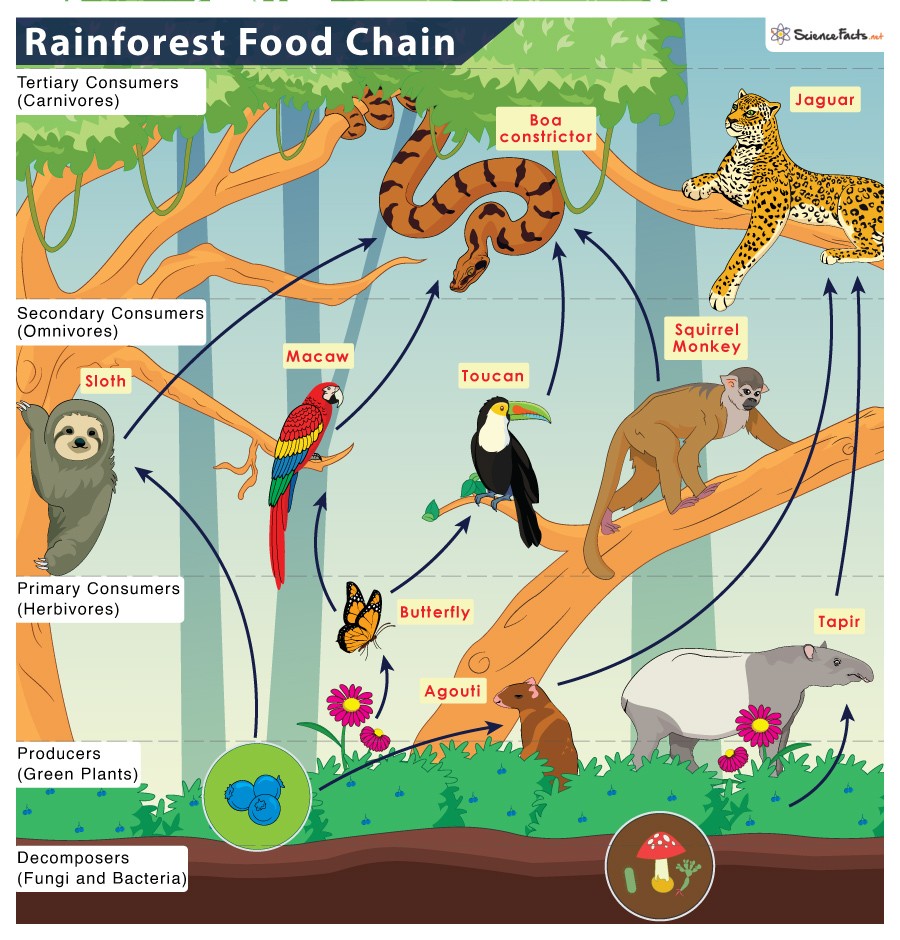Tropical rainforests are some of the most biodiverse ecosystems on Earth, teeming with an astonishing variety of plant and animal life. This lush environment, characterized by its warm temperatures and high rainfall, supports a complex network of life where energy flows intricately from one organism to another. Instead of a simple linear progression, the feeding relationships in a rainforest are better described as a vibrant and interconnected Tropical Rainforest Food Web.
To truly appreciate the complexity of a rainforest ecosystem, it’s essential to move beyond the idea of a basic food chain and delve into the intricate world of the food web. In a rainforest, organisms are interconnected in numerous ways, creating a web of life where energy and nutrients are constantly recycled and redistributed.
Deconstructing the Tropical Rainforest Food Web
Like any ecosystem’s food structure, the tropical rainforest food web is organized into trophic levels, each playing a crucial role in the flow of energy. Let’s break down these levels to understand how this web functions:
Producers: The Foundation of the Rainforest Food Web
At the base of the tropical rainforest food web are the producers. These are autotrophs, meaning they create their own food through photosynthesis, using sunlight, water, and carbon dioxide. Rainforests boast an incredible diversity of plant species, forming the foundation of this trophic level.
- Trees: Towering trees like teak, mahogany, and kapok dominate the rainforest canopy, providing the bulk of biomass and energy production.
- Flowering Plants: An astonishing array of flowering plants, including orchids, bromeliads, and heliconias, add to the producer diversity.
- Ferns and Mosses: These non-flowering plants thrive in the understory, contributing to the overall photosynthetic output.
- Algae: Microscopic algae, found in damp environments and water bodies, also play a role as primary producers.
- Bamboo and Banana Plants: These fast-growing plants are also significant producers in certain rainforest regions.
These producers capture solar energy and convert it into chemical energy in the form of glucose, forming the primary food source for the entire ecosystem.
 Rainforest Food Chain
Rainforest Food Chain
Primary Consumers: Herbivores of the Rainforest
Above the producers are the primary consumers, also known as herbivores. These organisms feed directly on the producers, obtaining energy by eating plants. The rainforest is home to a wide variety of primary consumers, each adapted to feed on different types of plant matter.
- Monkeys: Various monkey species, like howler monkeys and spider monkeys, consume fruits, leaves, and flowers in the canopy.
- Sloths: These slow-moving mammals primarily feed on leaves, buds, and tender shoots.
- Agouti: These large rodents forage on the forest floor, eating fruits, nuts, and seeds.
- Macaws and Parrots: These colorful birds feed on fruits, seeds, and nuts high in the trees.
- Fish: Herbivorous fish in rainforest rivers and streams consume aquatic plants and algae.
- Kangaroos (in Australian Rainforests): While less common in typical tropical rainforest discussions, kangaroos are primary consumers in Australian rainforest ecosystems.
These primary consumers play a vital role in transferring energy from the producers to the next trophic level.
Secondary Consumers: Carnivores and Omnivores in the Mid-Levels
Secondary consumers occupy the next level of the food web. They are typically carnivores or omnivores, feeding on primary consumers. This level adds another layer of complexity to the energy flow within the rainforest.
- Snakes (Boa Constrictors): These predators prey on rodents, birds, and other smaller animals.
- Lemurs: While some lemurs are primary consumers, others are omnivorous, eating insects, fruits, and small animals.
- Deer: Some deer species in rainforest fringes might be preyed upon by secondary consumers.
- Woodpeckers: These birds primarily feed on insects but can also consume sap and fruits, placing them partially in this category.
- Bats (Insectivorous): Many bat species are insectivores, consuming vast quantities of insects, and are considered secondary consumers.
- Owls: Nocturnal predators like owls hunt rodents and other small mammals.
- Kookaburras: These Australian birds are carnivorous, feeding on insects, snakes, and small mammals.
- Toucans (partially): While often considered scavengers or frugivores, toucans also prey on insects, smaller birds, and lizards, placing them in the secondary consumer category at times.
The secondary consumers help regulate populations of primary consumers and further distribute energy through the food web.
Tertiary Consumers: Apex Predators of the Rainforest
At the top of the tropical rainforest food web are the tertiary consumers, often apex predators. These carnivores prey on secondary consumers and have few or no natural predators themselves. They play a crucial role in maintaining the balance of the ecosystem.
- Jaguars: Powerful apex predators in the Americas, jaguars prey on a wide range of animals, including mammals, reptiles, and fish.
- Cougars (Pumas): Similar to jaguars, cougars are top predators in American rainforests.
- Leopards: In African and Asian rainforests, leopards are apex predators, hunting monkeys, deer, and other animals.
- Tigers: Majestic apex predators in Asian rainforests, tigers prey on large mammals.
- Crocodiles and Alligators: These large reptiles are apex predators in aquatic and semi-aquatic rainforest environments, preying on fish, mammals, and birds.
- Green Anacondas and Pythons: These giant snakes are apex predators, capable of constricting and consuming large prey.
- Philippine Eagles, Black Eagles, and Crowned Eagles: These powerful birds of prey are apex predators in the avian world of the rainforest, hunting monkeys and other birds.
Apex predators exert top-down control on the food web, preventing any single population from becoming dominant and maintaining species diversity.
Decomposers: The Rainforest Recyclers
Crucially important, but often unseen, are the decomposers. These organisms break down dead plants and animals, returning essential nutrients to the soil. Decomposers are the recyclers of the rainforest ecosystem, ensuring that nutrients are continuously available for producers.
- Fungi (Mushrooms): Fungi are primary decomposers, breaking down dead organic matter and releasing nutrients.
- Bacteria: Various types of bacteria in the soil also play a vital role in decomposition.
- Invertebrates (Termites, Earthworms): These organisms assist in breaking down organic matter and aerating the soil.
- Scavengers (Vultures, some insects): While not strictly decomposers, scavengers like vultures consume carrion, initiating the decomposition process and preventing the spread of disease.
Decomposers are indispensable for nutrient cycling, ensuring the long-term health and productivity of the tropical rainforest food web.
Interdependence and Competition: The Dynamics of the Food Web
The tropical rainforest food web is characterized by intense competition and intricate interdependence. Organisms compete for resources like food, sunlight, and territory, but they are also deeply interconnected, relying on each other for survival.
- Competition for Food: Numerous species compete for the same food sources, driving evolutionary adaptations and niche specialization.
- Predator-Prey Relationships: Predators control prey populations, preventing overgrazing and maintaining ecosystem balance. Prey species, in turn, evolve defenses against predation.
- Symbiotic Relationships: Many species engage in symbiotic relationships, such as mutualism (both benefit), commensalism (one benefits, the other is neutral), and parasitism (one benefits, the other is harmed), further weaving the web of life.
- Nutrient Cycling: Decomposers ensure the continuous recycling of nutrients, making them available for producers, which then support the entire food web.
This delicate balance of competition and interdependence is what makes the tropical rainforest food web so resilient yet also vulnerable. Disruptions at any level can have cascading effects throughout the entire system.
Conclusion: Protecting the Intricate Web of Life
The tropical rainforest food web is a complex and fascinating system, highlighting the interconnectedness of life and the flow of energy through an ecosystem. Understanding this intricate web is crucial for appreciating the fragility and importance of rainforests.
Threats such as deforestation, climate change, and species extinction pose significant risks to the delicate balance of the tropical rainforest food web. Protecting these invaluable ecosystems requires a comprehensive approach, focusing on conservation efforts, sustainable practices, and raising awareness about the vital role rainforests play in the global ecosystem. By understanding and valuing the tropical rainforest food web, we can contribute to preserving these biodiversity hotspots for future generations.

